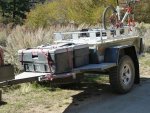So many of you are probably wondering what the cost of this was compared to the other options. I can simplify that with a couple of thoughts.
1) For 8k on the TransContinental model, it’s a fantastic option right out of the gate unaltered IMO. Seeing how the camper performed and the quality of the build I have every faith this base option would work for quite a few who want to have a capable offroad camper.
2) Mine was heavily modified and basically designed to my exacting specifications. It’s basically a custom one of a kind trailer. Needless to say it cost more, but it will help to understand how that compared to some other known campers on the market and the upgrades that contains.
3) The great thing about Glen and his shop is the ability and willingness to meet your needs. That means that anything between the base model and my uber customized version is possible with them. And for less than you might think.
For comparison, the following is what I’m including in the comparison. I’m not including things like the controllers, special coupler / hitch, inverters, custom tires / rims, fridge (which is a 1k+ option by itself). Basically this is the camper, ruggedized and upfitted storage for easier comparison.
1) Standard camper box (clamshell)
2) Stronger, extended, galvanized frame
3) Coil and leaf spring suspension upfit w/ 24” shocks
4) Electric brake axle
5) Water tank and hand pump
6) Custom sized / shaped aluminum storage well
7) Custom aluminum fenders
8) Add A Room addition with wall modifications (addtl length and door for fridge tray)
9) Installing battery and wiring for 3 point charging solution
10) Custom aluminum fridge box with dual sliding trays, locking doors (with gaskets), ventilation, and addtl storage tray on top
11) Addtl aluminum storage tray between camper box and fridge box
12) 20lb propane holder and tank
13) Adjustable support ‘legs’
14) Addtl aluminum strengthening to camper box storage area, mechanical tie downs
So while I won’t provide exact costs for that, I can relate it to some others on the market. The most recognized in this class of performance is the Campa and Adventure Trails options so I’ll use that and let he reader compare how the options stack up.
Campa Cub : Comes in a $8500 (base) - my spec’d out trailer with the options above was higher
Campa AT: I found this (base) listed at $14750 – my cost was lower
Adventure Trailer Horizon: Comes in at $10,481 (base) - my cost was higher
Adventure Trailer Chaser: Comes in at $7236 (base) – my cost was higher
Adventure Trailer Teardrop: Comes in at $13852 (base) – my cost was lower
A final addition that just recently came out, and seems to be a very good comparable, is the Adrenaline Camper. Aluminum for lightweight, offroad suspension / tires, clamshell opening, extremely ruggedized, etc. Base model shows to be $17500. In comparison to this my trailer, with the options above AND the addition of the controllers / inverters / tires / fridge / EVERYTHING else (so my current complete setup) was less than that…
So if you’ve read this far you get a gold star. Hope this helps, as I was helped by similar postings of others before me. I’ve also got a couple short videos of the camper in action, but no way to post them with my acct, sry. Enjoy, and happy camping!



















